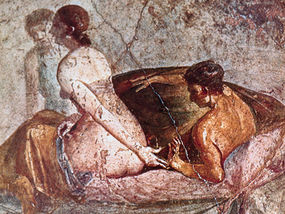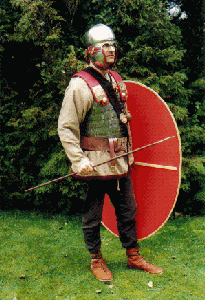 |
Byzantine Floor Mosaic, 500-550 A.D. (Metropolitan Museum of Art)
|
Brothels, Baths and Babes:
Prostitution in the Byzantine Holy Land
When addressing Byzantium it appears that much of the attention of academics and those that read this blog is focused on the obvious subjects; military history, imperial history; the rise and fall of the emperors; iconoclasm; art; and the development of the Orthodox Church. In most research very little has been written on the subject of sex.
The article below explores both the formal and informal arrangements that developed, typically centring around the triad of the wife, the concubine and the courtesan.
By Claudine Dauphin
Centre National de la Recherche Scientifique, Paris
Graeco-Roman domestic sexuality rested on a triad: the wife, the concubine and the courtesan. The fourth century BC Athenian orator Apollodoros made it very clear in his speech Against Neaira quoted by Demosthenes (59.122) that ‘we have courtesans for pleasure, and concubines for the daily service of our bodies, but wives for the production of legitimate offspring and to have reliable guardians of our household property’. Whatever the reality of this domestic set-up in daily life in ancient Greece, this peculiar type of ‘ménage à trois’ pursued its course unhindered into the Roman period: monogamy de jure appears to have been very much a façade for polygamy de facto. The advent of Christianity upset this delicate equilibrium. By forbidding married men to have concubines on pain of corporal punishment, canon law elaborated at Church councils took away from this triangular system one of its three components. Henceforth, there remained only the wife and the courtesan.
If we are to believe the Lives of the holy monks of Byzantine Palestine, the Holy Land (in particular the Holy City of Jerusalem, the aim of pilgrimages at the very heart of Christianity) was replete with ‘abodes of lust’ and prostitutes tracked down the monks in their secluded caves near the River Jordan. Thus, we are faced with a paradox: the coexistence of holiness and debauchery, of Christian asceticism and lust.
Lest we forget that virtue is meaningless without vice, that holiness cannot exist without lewdness, a fifth century AD Gnostic hymn from Nag-Hammadi in Middle Egypt proclaimed: ‘I am She whom one honours and disdains. / I am the Saint and the prostitute. / I am the virgin and the wife. / I am knowledge and I am ignorance. / I am strength and I am fear. / I am Godless and I am the Greatness of God’.
In the Old Testament, Jerusalem appeared as a Prostitute in dire need of purification through divine punishment (Ez. 16 and 23). Her degradation contrasted with her original faithfulness: ‘How the faithful city has become a harlot, she that was full of justice!’, the prophet Isaiah (1:21) lamented. St John applied the epithet Prostitute ‘clothed in fine linen, in purple and scarlet, bedecked with gold, with jewels, and with pearls!’ (Rev. 18.16-17) to the idol-worshipping Great City, Babylon, Rome and ultimately to any great urban concentration.
A similar opinion was held by the rabbis of the Babylonian Talmud in the fifth century AD who considered that a bachelor who succeeded in remaining chaste in a large city was without any doubt an excessively pious man. Likewise, the monks of Nitria (modern Wadi Natrun), of the Kellia and of Scetis in Egypt and those of the Judaean Desert in Palestine, considered that the city was par excellence a den of iniquity, of temptation and of sin. Harbours with international maritime trade links such as Alexandria and Beirut, and the universal Christian capital Jerusalem, both provided their innkeepers and harlots with a cosmopolitan clientèle of residents, travellers and pilgrims.
 |
| Ancient Greece Sex |
Prostitution
In the streets
Byzantine erotic epigrams, notably those of Agathias Scholasticus in the sixth century, generally describe encounters with prostitutes in the street.[5] The winding, dark alleyways of the Old City of Jerusalem were particularly appropriate for soliciting by scortae erraticae or ambulatrices. These lurked under the high arches which bridged the streets of the Holy City and walked up and down the cardo maximus.In the small towns of Roman and Byzantine Palestine, however, it seems that the squares (not the streets) were the favourite hunting-grounds of prostitutes. Rabbi Judah observed: “‘How fine are the works of this people [the Romans] ! They have made streets, they have built bridges, they have erected baths !’. Rabbi Yose was silent. Rabbi Simeon ben Yohai answered and said, ‘All what they made, they made for themselves; they built market-places, to set harlots in them; baths to rejuvenate themselves; bridges to levy tolls for them’” (Babylonian Talmud, Shabbat 33b).
At Home
Some harlots worked at home, either on their own account, such as Mary the Egyptian whose Life was written down in the sixth century by Sophronios, the last Patriarch of Jerusalem before the Arab Conquest, or for a pimp. On the evidence of the legislation of Emperor Justinian in the mid-sixth century, in particular Novella 14 of 535, it is clear that providing housing was part of the deal which the pimps of Constantinople struck with the fathers of the young peasant girls whom they bought in the capital’s hinterland.
Housing did not necessarily mean a house, and was frequently only a shack, hut or room. Byzantine prostitutes were relegated to ‘red light districts’ in the same way that the prostitutes of Rome lived and worked predominantly in Subura and near the Circus Maximus, thus to the north and south of the Forum. In the late sixth-century Life of John the Almsgiver, Patriarch of Alexandria, Leontios of Neapolis describes a monk coming to Tyre on some errand. As he passed through ‘the place’, he was accosted by a prostitute who cried out: ‘Save me, Father, like Christ saved the harlot’, this referring to Luke 7:37. These districts were generally the most destitute areas in town.
The Babylonian Talmud (Pesahim 113b) relates how Rabbi Hanina and Rabbi Hoshaia, both poor cobblers in the Land of Israel, dwelt in a street of harlots for whom they made shoes. The prostitutes were so impressed by these rabbis’ chastity (for they would not even lift their eyes to look at the girls) that they took to swearing ‘by the life of the holy rabbis of Eretz Yisrael’!
In Tavernae
In city inns (tavernae) as well as in the staging posts for change of mounts (mutationes) or overnight stay (mansiones) along the official Roman road network (the cursus publicus), all the needs of travellers were catered for by the barmaids.
They served them wine, danced for them and often led them upstairs to the rooms on the upper floor. In fact, according to the Codex Justinianus, a barmaid could not be prosecuted for adultery, since it was presumed that she was anyway a prostitute (CJ 9.9.28).
In order to prevent Christian travellers from falling prey to sexual dangers of this sort, ecclesiastical canons forbade the clergy to enter those establishments. Soon, therefore, ecclesiastical resthouses (xenodochia) and inns specifically for pilgrims (pandocheia) run by members of the clergy, sprang up along the main pilgrim routes.
 |
| Sex in Pompeii |
Brothels
Prostitution was also institutionalised under the form of brothels which Juvenal called lupanaria (Sat. 11.172-173) and Horace fornices (Ep. 1.14.21). These, John Moschus described in his sixth-century Spiritual Meadow as a ‘house of prostitution’ in Jericho or even more vaguely ‘an abode of lust’ in Jerusalem (Prat. Spir. 17). The prostitutes who were employed in these establishments were slaves and the property of a pimp (leno) or of a ‘Madam’ (lena).
The very name of the prostitute in Tyre who called out to a monk to save her – Kyria Porphyria – is telling. She was so used as a ‘Madam’ to boss other women, that once she had been reformed and had convinced other harlots (presumably her former ‘girls’) to give up prostitution, she organised them into a community of nuns of which she became the abbess – the mirror image of her brothel.
A Byzantine brothel has recently been unearthed in the course of excavations at Bet She’an, ancient Scythopolis, capital of Palaestina Prima. At the heart of this thriving metropolis, a Roman odeon founded in the second half of the second century was partly destroyed in the sixth century. Byzantine Baths adjoined it to the west. To the south-west, the second row of shops of the western portico of the impressive Street of Palladius was also dismantled to make way for a semi-circular exedra (13x15m). Each half of the exedra comprised six trapezoidal rooms with front doors. Some of these rooms also opened onto a corridor or a hall at the back of the building. In one room, a staircase led to an upper storey. Some rooms had niches with grooves for wooden shelves. The apses at both ends of the exedra and in the centre of the semi-circle, as well as the façades of the rooms were revetted with marble plaques, most of which are now lost, there only remaining holes for the nails which held these plaques in position. The inner faces of the walls of these rooms exhibited two coats of crude white plaster.
The floor of most of these rooms was paved with mosaics depicting geometric motifs enclosing poems in Greek, animals and plants, and lastly, in an emblema, a magnificent Tyche crowned by the walls of Scythopolis and holding a cornucopia. The mosaic pavements of some rooms had been subsequently replaced by bricks or a layer of crushed lime. Traces of crude repairs in the mosaics and the insertion of benches in other rooms indicated that the building had undergone various stages of construction. A semi-circular courtyard (21x30m) stretched in front of the twelve rooms. Towards the street, it was closed off by a set of rooms which incorporated the shops previously at the northern end of the portico of the Street of Palladius, whilst putting them to a different use. This row of rooms which was probably interrupted by the main entrance into the complex, opened onto a portico with an opus sectile floor of black and white marble. Two steps running for the entire length of the portico enabled access from the street. The portico and the rooms had a tiled roof. The exedra was demolished at the end of the sixth century or in the early seventh century.
The cabins of the Bet She’an exedra are reminiscent of the cells of the Pompeii lupanarium which consisted of ground floor rooms, each equipped with a stone bed and a bolster. An external staircase provided access to the first floor balcony onto which opened five more spacious rooms. At Bet She’an, the back doors of some rooms on the ground floor enabled clients who were keen to remain anonymous, to enter an abode of lust without being seen from the main street and thus to surreptitiously satisfy their sexual fantasies.
The portico where the girls strolled in the hope of attracting passers-by from the Street of Palladius, as well as the neighbouring Byzantine Baths were part of a fascinating network: soliciting at the Baths, in the portico and in the exedra courtyard, followed by sex in the cabins; and at the back of the building, an entrance-and-exit system for supposedly ‘respectable clients’.
 |
| The Roman / Byzantine Provinces of the greater Holy Land. |
(Classics Ireland.com) (Express.co.uk - The Roman Empire of sex)

















